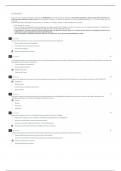Samenvatting
Samenvatting Behavioral Finance
- Instelling
- Vrije Universiteit Amsterdam (VU)
Samenvatting en college aantekeningen van het vak Behavioral Finance. Behaald resultaat: 9,6 Summary and lecture notes of the course Behavioral Finance. Result: 9.6
[Meer zien]














